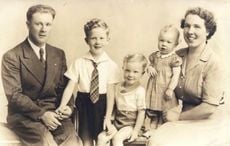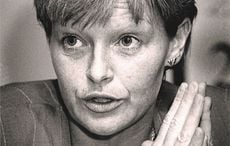It was a reflection of the spirit of adventure she showed throughout her life that Mary Kilroy was delighted to take part in a documentary film called ‘Older Than Ireland’ at 101 years of age.
Like all the other centenarians who took part in the film, my grandmother was happy to share her thoughts on a long life lived to the full on the big screen.
All 30 of them were born under the British Empire, and lived through the 1916 Easter Rising, the birth of a new Ireland, and two world wars.
Yet, as film-maker Alex Fegan discovered, most of them were happier to talk about their own personal tragedies, triumphs, loves and losses than the great political and social changes they had witnessed throughout their lives.
When Alex arrived at my grandmother’s farm-house in Caltra, Co Galway, to film an interview last year he found a lady dressed to the nines for an auspicious occasion, happy to tell an abundance of stories from her long and wonderful life.
A few people who saw the film, but never met Granny Kilroy, said that she struck them as a real character with an amazing sense of humour and a heart of gold.
Like many of the interviewees in ‘Older Than Ireland’, my granny didn’t have an easy life. Which is probably why she had such a rebellious streak, and such a sense of fun, by the time her grandchildren came into this world.
She married into a house which had been shot up by the notorious Black ‘n’ Tans, the British reserves who became infamous for their attacks on Irish civilians at the height of the War of Independence.
The Ireland of my granny’s youth was a turbulent place and my grandfather’s brother, who later became a senior Garda (or policeman), had been a wanted man. He was the leader of the Irish Republican Army (IRA) in north-east Galway.
He spent time on the run, and in prison, as the Irish fought for independence during my grandmother’s childhood. One of his neighbours spent five years on the run, hiding in hay-sheds and getting fed by country people, as I was to discover during the 1916 commemorations in Caltra earlier this year.
When she married Micheal Kilroy, Mary Mannion moved from Menlough to Rabane, Caltra, where she raised nine children in a two-bedroomed house on a small farm.
She caused quite a stir in the documentary when she talked of having “loads” of admirers in her youth and of her relationship with a Protestant which didn’t go down well in a deeply divided country.
“Well, I had loads of them! They’re always codding me about that here. Oh, there was no scarcity of boyfriends,” she told Alex on film.
“I was doing a line with a fella who was a Protestant and he was a nice fella and everything, but my grandmother and mother and all said ‘do you want to disgrace us?’ And, oh, he was such a nice lad. But I’m telling you, I got rid of him quick enough. I had to let him off,” she laughed.
In later years, Granny would always “cod” her own 34 grandchildren about our relationships (or lack of them!). She took a keen interest in our love-lives, only because she wanted us all to be happy, as she had been with our grandfather.
Her Rabane house was always a sociable place; people would pop in for a chat at all hours of the day and play music around the hearth fire. But Granny was the boss, and you wouldn’t want to overstay your welcome.
Although a practicing Catholic, she showed a rebellious streak through the 1950s and 1960s.
If a book by John McGahern or Edna O’Brien was banned, Granny Kilroy was sure to manage to get her hands on a copy to see what all the fuss was about. She’d be sure to arrange to have the banned books brought back to Caltra from England.
She loved any Irish writer who had a good sense of humor or appreciation for rural life, particularly Kerry playwright John B. Keane, and kept a scrapbook containing his most amusing newspaper columns.
She loved the theatre, and Irish literature in general.
Life was never to be taken too seriously, so we’d enjoy tall tales around her kitchen table or a flutter on the horses during the Galway Races. She’d even sneak a cigarette or taste of brandy to a willing grandchild, as long as the “responsible” adults weren’t around to witness her “delinquent” behavior!
She outlived her husband by over 50 years and buried two sons. The passing of her eldest son, Paddy, at 28 years of age, was a particularly tough blow. But, as my mother Mary said at her huge 100th birthday party in Athlone almost three years ago, Granny Kilroy never let tragedy define her long life.
She taught all of her extended family the value of getting on with life, of putting a positive spin on things, and of having the ‘craic’ or some fun along the way, even if there was not always an abundance of food on the table.
Even at 101, she still extended a warm welcome to visitors. When the ‘Older Than Ireland’ crew visited her home, Granny marvelled that she had received 20 bottles of brandy for her 100th birthday – and was quick to offer a drop to her visitors.
She was a great support to my own immediate family when we lost my sister, Cliona, to cancer at 16 years of age. Granny Kilroy epitomized the importance of getting up, getting out, and putting a brave face on a new day, even (or especially) in the aftermath of tragedy.
As a teenager, when I secured a summer job in Galway, my parents (perhaps rightly!) would not trust me to stay at home on my own.
Fearful that the family home would be ruined by house parties, they would invite my granny in to the city to “supervise” me for two weeks.
The result was a fortnight of merriment, laughter, and irreverence in the family home, and more than a few nights out at Ward’s pub in Lower Salthill, where she’d be delighted to get chatting to the locals.
Even in her late nineties, she would sneak off to Athlone or Ballinasloe with her beloved grand-daughters to buy a new outfit for Christmas or a wedding, because Granny Kilroy always maintained a big interest in style and fashion.
In her beautiful Eulogy at Caltra Church last week, my cousin Fiona O’Driscoll recalled her love of style and fashion. Fiona grew up on the farmhouse with my gran.
“You live but once; you might as well be amusing,” she quoted Coco Chanel, a fitting motto for my granny’s fun-filled life.
Only our granny would make a big deal of recalling the exact number of birthday cards she got (452!) when she turned 100.
Her younger sister, Margaret, also reached a century and it used to bug our granny enormously when Margaret refused to disclose how many cards she received for reaching that wonderful milestone.
For ten weeks in a row, she used to visit Margaret every Thursday, but she could never elicit the exact number from her sibling. At 101 and 100, they maintained a very close friendship, but also a keen sibling rivalry.
There are a lot of things that annoy me about life in the West of Ireland . . . the climate, the way in which gombeens rise to the top of so many organizations . . . and yet my grandmother’s death last week brought home to me all that is good about life in this part of the world.
It was so wonderful that Granny was able to pass away peacefully, in her own home, surrounded by people who love her. If only all human beings could have such a peaceful ending after living such full and rewarding lives.
The gentle nature we have with each other, the sense of compassion, the strong family bonds and community spirit in rural areas were all reflected in an estimated attendance of 4,500 at her Removal in Mountbellew.
Granny would have been well impressed that we were two hours late getting to the church!
Having experienced too many tragic deaths, I expected my gran’s death to be a celebration of a long and wonderful life – and yet when I looked around the Church last Thursday I was amazed to see so many people in tears at the passing of a true local legend.
People should not really be in tears when someone reaches 102 years of age, but our gran was clearly held in high esteem by her local rural community, where her sense of humour was legendary, as much as by her wide extended family.
Granny Kilroy brought so much joy to the lives of her 34 grandchildren that the outpouring of love in Caltra last week was simply unforgettable.
All week, we’ve been swapping anecdotes of childhood adventures (and misdaventures!).
While some feigned shock at some of the things she said on camera, we are all now so thrilled that she allowed her warm personality to come across on the big screen when she agreed to be filmed for ‘Older Than Ireland’.
With a laugh, she told Alex that she’d ask St Peter “how ya doin’?” and “How’s she cuttin’?” if she was to meet him at the gates of Heaven.
Truly, she lived a remarkable life.
This article was submitted to the IrishCentral contributors network by a member of the global Irish community. To become an IrishCentral contributor click here.




Comments